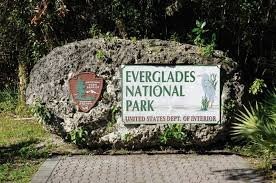Everglades National Park, Flamingo Visitor Center
Introduction
Text-to-speech Audio
Images
Everglades National Park sign (photo credit: Mates Guide at https://mates.guide/featured/exploring-everglades-national-park-in-miami.html)

Backstory and Context
Text-to-speech Audio
Flamingo Visitor Center offers informational brochures, educational displays, and backcountry permits. Everglades National Park is a 1.5-million-acre wetlands preserve on the southern tip of the U.S. state of Florida. This park is most often compared to a grassy, slow-moving river that is made up of coastal mangroves, sawgrass marshes, and pine flatwoods. This park is home to hundreds of animal species. Among the Everglades' abundant wildlife are the endangered Florida panther, leatherback turtle, and West Indian manatee.
The history of the park goes back before the 1900s as water in south Florida once flowed freely from the Kissimmee River to Lake Okeechobee. Then flowed southward over low-lying lands to the estuaries of Biscayne Bay, the Ten Thousand Islands, and Florida Bay. The shallow, slow water covered virtually 11,000 square miles in which created a mosaic of ponds, sawgrass marshes, sloughs, hardwood hammock, and forested uplands.
For thousands of years, this complex system evolved into a finely balanced ecosystem that formed the biological infrastructure for the southern half of the state. However, the Everglades were potential farm land and communities to early colonial settlers and developers. The drainage process to transform wetland to land was underway by the early 1900s'. The results of this process ended up being severely damaging to the ecosystem and the species that it supported.
Everglades National Park was established in 1947 to conserve the natural landscape and prevent further degradation of its land, plants, and animals by many early conservationists, scientists, and other advocates. An alluring human story of the Everglades is deeply interwoven with its endless marshes, dense mangroves, towering palms, alligator holes, and tropical fauna, although the captivation of the Everglades has mostly stemmed from its unique ecosystem. The history of this park rages from Native Americans whom existed and thrived in these waters, agricultural development and drainage of the Everglades, the individuals and groups who advocated for the conservation of the area, the Everglades’ role in United States War efforts, and the preservation and restoration work that continues today.
Cite This Entry
Carr, Aimee. "Everglades National Park, Flamingo Visitor Center." Clio: Your Guide to History. May 3, 2018. Accessed January 20, 2025. https://theclio.com/entry/59293


